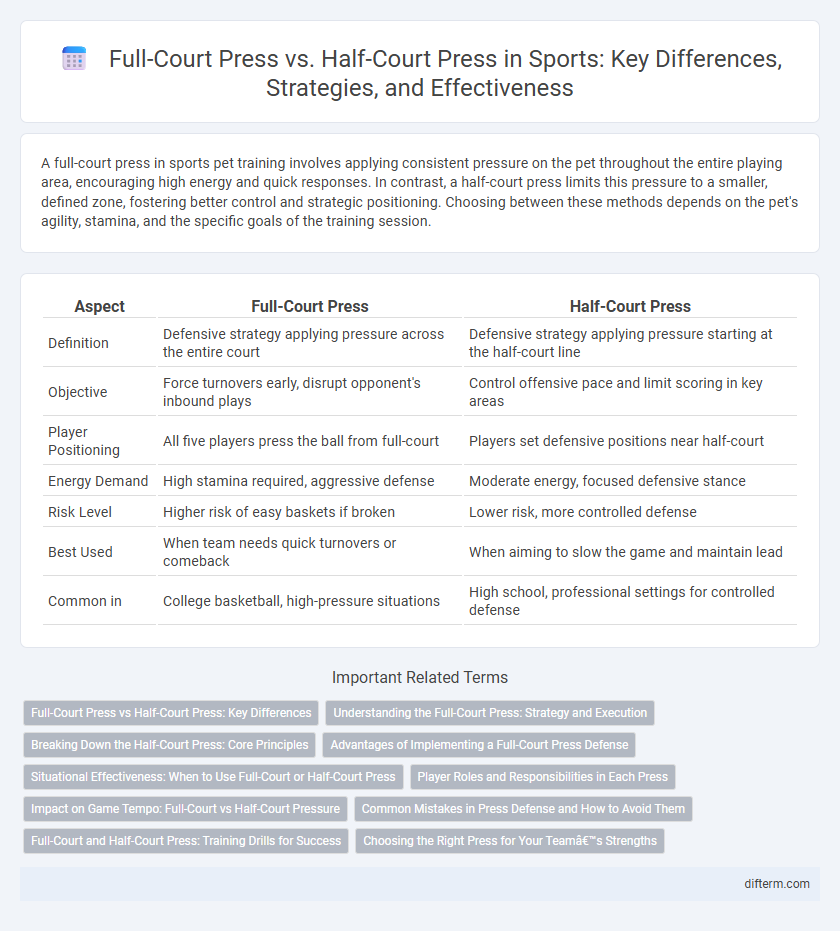A full-court press in sports pet training involves applying consistent pressure on the pet throughout the entire playing area, encouraging high energy and quick responses. In contrast, a half-court press limits this pressure to a smaller, defined zone, fostering better control and strategic positioning. Choosing between these methods depends on the pet's agility, stamina, and the specific goals of the training session.
Table of Comparison
| Aspect | Full-Court Press | Half-Court Press |
|---|---|---|
| Definition | Defensive strategy applying pressure across the entire court | Defensive strategy applying pressure starting at the half-court line |
| Objective | Force turnovers early, disrupt opponent's inbound plays | Control offensive pace and limit scoring in key areas |
| Player Positioning | All five players press the ball from full-court | Players set defensive positions near half-court |
| Energy Demand | High stamina required, aggressive defense | Moderate energy, focused defensive stance |
| Risk Level | Higher risk of easy baskets if broken | Lower risk, more controlled defense |
| Best Used | When team needs quick turnovers or comeback | When aiming to slow the game and maintain lead |
| Common in | College basketball, high-pressure situations | High school, professional settings for controlled defense |
Full-Court Press vs Half-Court Press: Key Differences
Full-court press applies intense defensive pressure across the entire court, forcing turnovers and speeding up the game pace, whereas half-court press limits pressure to the opponent's frontcourt, focusing on controlling specific zones and reducing fatigue. Full-court press requires high stamina and teamwork to sustain pressure for an extended period, while half-court press prioritizes positioning and strategic trapping to disrupt opponent offenses. Understanding the physical demands and tactical goals of each press is crucial for coaches optimizing defensive efficiency in basketball.
Understanding the Full-Court Press: Strategy and Execution
The full-court press is a defensive basketball strategy applied across the entire court, designed to pressure the offensive team immediately after the inbound, forcing turnovers and disrupting play rhythm. This aggressive tactic requires high stamina and coordination among defenders to trap ball handlers and intercept passes effectively. Proper execution hinges on quick rotations, communication, and anticipating the opponent's offensive moves to maximize defensive pressure and generate fast-break opportunities.
Breaking Down the Half-Court Press: Core Principles
The half-court press focuses on applying defensive pressure beginning at the opponent's half-court line, emphasizing strategic positioning and anticipation to disrupt offensive plays. This tactic conserves player energy compared to a full-court press, allowing defenders to maintain intensity throughout the game while forcing turnovers through psychological pressure. Key principles include crowding passing lanes, controlling the tempo, and communication to seamlessly switch defensive assignments.
Advantages of Implementing a Full-Court Press Defense
Implementing a full-court press defense in basketball maximizes defensive pressure by disrupting an opponent's offensive rhythm early, often forcing turnovers and quick mistakes. This strategy enhances team communication and stamina, accelerating transitions from defense to offense and creating fast-break scoring opportunities. Full-court press also limits opponents' time and space for decision-making, increasing the defensive effectiveness across all positions on the court.
Situational Effectiveness: When to Use Full-Court or Half-Court Press
A full-court press is most effective in creating turnovers and applying intense defensive pressure early in the game or when trailing, as it disrupts the opponent's offensive flow across the entire court. A half-court press is better suited for conserving energy while maintaining pressure, ideal in close games or late-game situations to force contested shots near the basket. Coaches often choose full-court presses for aggressive momentum shifts and half-court presses for controlled defense during critical moments.
Player Roles and Responsibilities in Each Press
In a full-court press, players are tasked with aggressive ball pressure and trapping immediately after the inbound, requiring point guards and wings to apply intense defensive pressure and wings to deny passing lanes, while forwards and centers secure rebounds and protect the basket. The half-court press focuses on structured positioning, where perimeter defenders anticipate ball handlers at mid-court and wings cover passing options, while bigs prepare for rim protection and rebound containment. Each press demands specialized player roles that prioritize stamina, communication, and spatial awareness to disrupt the opponent's offensive flow.
Impact on Game Tempo: Full-Court vs Half-Court Pressure
Full-court press intensifies game tempo by forcing quicker decisions and accelerating offensive possessions, often leading to turnovers and fast-break opportunities. Half-court press controls pace more strategically, slowing the opponent's attack to disrupt rhythm without expending as much player energy. Teams employing full-court pressure typically see increased scoring runs and defensive stops, whereas half-court presses create steadier, more controlled game tempo adjustments.
Common Mistakes in Press Defense and How to Avoid Them
Common mistakes in full-court and half-court press defenses include overcommitting on traps, leading to easy breaks and poor rotation, and neglecting communication, which causes confusion and missed assignments. To avoid these errors, defenders must maintain disciplined spacing, prioritize quick and vocal communication, and practice switching seamlessly to cover gaps effectively. Emphasizing anticipation and team awareness reduces vulnerability to backdoor cuts and fast breaks.
Full-Court and Half-Court Press: Training Drills for Success
Effective full-court press training drills emphasize agility, stamina, and rapid decision-making to maintain constant pressure across the entire court. Half-court press drills focus on strategic positioning, communication, and coordinated trapping within a defined area to disrupt offensive plays and force turnovers. Incorporating these specialized drills enhances team defensive intensity and improves overall court coverage in competitive basketball.
Choosing the Right Press for Your Team’s Strengths
Selecting between a full-court press and a half-court press depends on your team's endurance, speed, and defensive skills. Teams with quick, agile players benefit from a full-court press to apply constant pressure and force turnovers early. Conversely, a half-court press suits squads with strong positional defenders who excel in organized, strategic trapping closer to the basket.
full-court press vs half-court press Infographic

 difterm.com
difterm.com